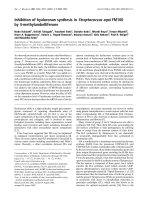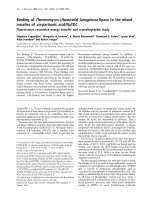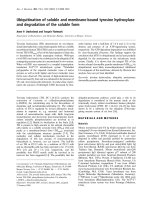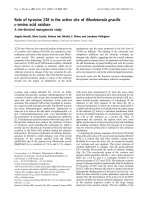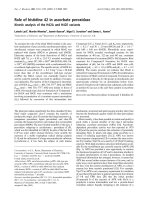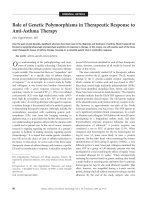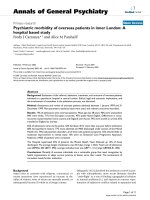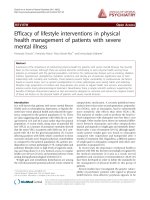Báo cáo y học: "Ubiquitination of HTLV-I Tax in response to DNA damage regulates nuclear complex formation and nuclear export" pps
Bạn đang xem bản rút gọn của tài liệu. Xem và tải ngay bản đầy đủ của tài liệu tại đây (790.9 KB, 12 trang )
BioMed Central
Page 1 of 12
(page number not for citation purposes)
Retrovirology
Open Access
Research
Ubiquitination of HTLV-I Tax in response to DNA damage
regulates nuclear complex formation and nuclear export
Michael L Gatza, Tajhal Dayaram and Susan J Marriott*
Address: Department of Molecular Virology and Microbiology, Interdepartmental Program in Cell and Molecular Biology, Baylor College of
Medicine, Houston, Texas 77030, USA
Email: Michael L Gatza - ; Tajhal Dayaram - ; Susan J Marriott* -
* Corresponding author
Abstract
Background: The HTLV-I oncoprotein, Tax, is a pleiotropic protein whose activity is partially
regulated by its ability to interact with, and perturb the functions of, numerous cellular proteins.
Tax is predominantly a nuclear protein that localizes to nuclear foci known as Tax Speckled
Structures (TSS). We recently reported that the localization of Tax and its interactions with cellular
proteins are altered in response to various forms of genotoxic and cellular stress. The level of
cytoplasmic Tax increases in response to stress and this relocalization depends upon the
interaction of Tax with CRM1. Cellular pathways and signals that regulate the subcellular
localization of Tax remain to be determined. However, post-translational modifications including
sumoylation and ubiquitination are known to influence the subcellular localization of Tax and its
interactions with cellular proteins. The sumoylated form of Tax exists predominantly in the nucleus
while ubiquitinated Tax exists predominantly in the cytoplasm. Therefore, we hypothesized that
post-translational modifications of Tax that occur in response to DNA damage regulate the
localization of Tax and its interactions with cellular proteins.
Results: We found a significant increase in mono-ubiquitination of Tax in response to UV
irradiation. Mutation of specific lysine residues (K280 and K284) within Tax inhibited DNA damage-
induced ubiquitination. In contrast to wild-type Tax, which undergoes transient nucleocytoplasmic
shuttling in response to DNA damage, the K280 and K284 mutants were retained in nuclear foci
following UV irradiation and remained co-localized with the cellular TSS protein, sc35.
Conclusion: This study demonstrates that the localization of Tax, and its interactions with cellular
proteins, are dynamic following DNA damage and depend on the post-translational modification
status of Tax. Specifically, DNA damage induces the ubiquitination of Tax at K280 and K284.
Ubiquitination of these residues facilitates the dissociation of Tax from sc35-containing nuclear foci,
and stimulates nuclear export of Tax through the CRM1 pathway.
Introduction
Human T-cell leukemia virus type I (HTLV-I) is the etio-
logical agent of adult T-cell leukemia (ATL) [1,2].
Although the mechanisms that regulate HTLV-I-mediated
cellular transformation have not been fully elucidated, it
is clear that the viral oncoprotein Tax is a central compo-
nent in this process [3]. Tax is a pleiotropic protein that
can deregulate various cellular processes including gene
Published: 14 December 2007
Retrovirology 2007, 4:95 doi:10.1186/1742-4690-4-95
Received: 3 July 2007
Accepted: 14 December 2007
This article is available from: />© 2007 Gatza et al; licensee BioMed Central Ltd.
This is an Open Access article distributed under the terms of the Creative Commons Attribution License ( />),
which permits unrestricted use, distribution, and reproduction in any medium, provided the original work is properly cited.
Retrovirology 2007, 4:95 />Page 2 of 12
(page number not for citation purposes)
expression, cell cycle progression, and DNA repair [3-5].
The ability of Tax to perturb these processes depends upon
its ability to interact with and dysregulate the activities of
numerous cellular proteins [6-10]. Recent evidence has
indicated that these interactions are not static and, in fact,
are influenced by cellular conditions that affect post-trans-
lational modification [11-14].
Tax is ubiquitously expressed in heterogeneous nuclear
foci known as Tax Speckled Structures (TSS), as well as
more diffusely in the cytoplasm [9,11,15]. Both the
nuclear and cytoplasmic activities of Tax are essential for
cellular transformation [4,9,16]. Recent reports have indi-
cated that the recruitment and/or retention of Tax binding
partners within TSS, and elsewhere in the cell, is regulated
by the post-translational modification status of Tax
[13,17,18]. When fused to a SUMO monomer, Tax is
localized predominantly to TSS and sumoylation of Tax is
required for the formation of nuclear foci containing both
RelA/p300 and Tax [12,13]. Conversely, ubiquitination,
or fusion of Tax to a ubiquitin monomer, targets Tax to
the cytoplasm and is required for Tax binding to the Ikap-
paB kinase complex and nuclear translocation of RelA
[12,13]. Further, ubiquitination and sumoylation of Tax
occurs on the same C-terminal lysine residues indicating
that these modifications are mutually exclusive. Thus, the
subcellular localization of Tax, as well as its ability to
interact with specific cellular proteins, appear to be regu-
lated by these post-translational modifications [12,13].
Despite these findings, it is unclear how the post-transla-
tional modification status of Tax is regulated.
We recently reported that the subcellular localization of
Tax, as well as its ability to interact with specific cellular
proteins, are dynamic and are susceptible to various gen-
otoxic stress-inducing agents [11]. In response to stress,
the number and intensity of TSS is reduced and Tax relo-
calizes to the cytoplasm. The subcellular localization of
Tax following stress phenotypically resembles that of
ubiquitinated Tax [12,13]. Therefore, we hypothesized
that DNA damage induces ubiquitination of Tax, which
subsequently regulates its subcellular distribution. Here
we demonstrate that DNA damage results in increased
mono-ubiquitination of Tax. Mutation of Tax amino acids
known to be targets of ubiquitination (K280 and K284)
inhibited DNA damage-induced ubiquitination of Tax,
resulting in retention of Tax within nuclear foci that con-
tain sc35, a splicing factor that was previously shown to be
a component of TSS [9,11,15]. We also showed that cyto-
plasmic transport of ubiquitin-Tax (UB-Tax) fusion pro-
teins is regulated through a CRM1-dependent mechanism
[19-21]. Inhibition of the CRM1 nuclear export pathway
resulted in an accumulation of UB-Tax in nuclear speck-
les. These results are consistent with previous findings
showing that the redistribution of Tax in response to DNA
damage is regulated by the CRM1 nuclear export pathway
[11]. Collectively, these results demonstrate that the sub-
cellular localization of Tax, and its interactions with cellu-
lar proteins, which respond dynamically to DNA damage
[11], are regulated, in part, by ubiquitination of Tax at
lysine residues 280 and 284.
Results
Cytoplasmic localization of ubiquitinated Tax is
leptomycin B sensitive
The wild-type HTLV-1 Tax protein localizes predomi-
nately in nuclear foci known as Tax speckled structures
(TSS). Previous studies have demonstrated that ubiquiti-
nation of Tax changes its distribution to a more diffuse,
predominately cytoplasmic localization [12-14]. Since UV
irradiation also causes a transient relocalization of Tax to
the cytoplasm [11], we investigated the possibility that UV
irradiation induces Tax ubiquitination. Consistent with
previous reports, we found that Tax expressed in 293 cells
formed nuclear foci under normal cell culture conditions
(Figure 1A). Following UV irradiation (30 J/m
2
, 30 min) a
rapid relocalization of Tax to the cytoplasm was observed,
coincident with a decreased number and intensity of
nuclear foci (Figure 1B). Ubiquitin-tags fused to the N- or
C-terminus of Tax also localized to the cytoplasm of 293
cells (Figure 1C and 1E, respectively), although linkage of
the Ub moiety to the C-terminus of Tax showed more
cytoplasmic localization than did linkage to the N-termi-
nus. The degree of cytoplasmic localization of these con-
structs could be due to tertiary structural effects of the Ub
tag, or to differential effects of the Ub tag on protein inter-
actions.
Tax contains both nuclear localization (NLS) and nuclear
export (NES) sequences that enable it to shuttle between
the nucleus and cytoplasm [11,22-24]. The cytoplasmic
distribution of ubiquitin-Tax fusion proteins suggests that
the ubiquitin modification either facilitates the export of
Tax to the cytoplasm or that it inhibits the import of Tax
to the nucleus. Either of these activities would result in the
cytoplasmic accumulation of Tax. To distinguish between
these possibilities, 293 cells expressing UB-Tax or Tax-UB
were treated with leptomycin B (LMB), a CRM1 inhibitor
[25,26] that has been shown to inhibit the export of Tax
from the nucleus in response to UV irradiation [11]. The
expression of UB-Tax, Tax-UB and native Tax is shown in
Figure 1H. Tax localization was monitored by immun-
ofluorescent microscopy. Following LMB treatment, both
UB-Tax, (Figure 1D) and Tax-UB (Figure 1F) were
observed predominantly in nuclear foci, similar to the dis-
tribution of wild-type Tax in unirradiated 293 cells (Figure
1A). The subcellular distribution of Tax in each panel was
quantified by scoring five hundred transfected cells, from
three independent experiments, for the presence of TSS
and cytoplasmic Tax (Figure 1G). We, and others, have
Retrovirology 2007, 4:95 />Page 3 of 12
(page number not for citation purposes)
previously shown that LMB does not affect the subcellular
localization of wild-type Tax [11,22]under normal cellu-
lar conditions. Taken together, these results suggest that
Ub-Tax is exported using the CRM-1 pathway.
UV irradiation increases the mono-ubiquitination of Tax
The finding that nuclear export of ubiquitinated Tax uti-
lizes the CRM1 pathway (Figure 1), combined with our
previous knowledge that nuclear export of Tax in response
to DNA damage is mediated through a CRM1 dependent
mechanism [11], suggested that Tax becomes ubiquiti-
Effect of ubiquitination on subcellular localization of TaxFigure 1
Effect of ubiquitination on subcellular localization of Tax. Tax localization alone (A-F, top row) or together with DAPI
to visualize the nucleus (A-F, bottom row) was examined by immunofluorescent microscopy in transfected 293 cells. Tax is
expressed in nuclear foci in the absence of DNA damage (A) and is localized in the cytoplasm following UV irradiation (B). The
addition of a UB tag at either the N- (C) or C- (E) termini caused Tax to be localized in the cytoplasm but treatment with LMB
(D and F) sequestered UB-Tax and Tax-UB to nuclear foci. All images are shown at a magnification of 63×. The percentage of
cells expressing nuclear foci (black bar) or cytoplasmic Tax (gray bar) was scored in five hundred transfected cells, in three
independent experiments (G). Western blot showing expression of UB-Tax, Tax-UB, and native Tax proteins (H).
Retrovirology 2007, 4:95 />Page 4 of 12
(page number not for citation purposes)
nated following DNA damage. To test this possibility,
wild-type Tax and HA-tagged UB were transiently
expressed in 293 cells for 48 hours and the cells were
mock or UV (30 J/m
2
) irradiated. The ubiquitination sta-
tus of Tax was examined by immunoprecipitating Tax
from cellular lysates thirty minutes after irradiation.
Lysates were analyzed by immunoblotting with α-Tax or
α-HA antibodies to detect Tax and UB-Tax, respectively
(Figure 2). Analysis of both unirradiated and UV-irradi-
ated samples by anti-Tax immunoblot showed the
expected 40 kDa Tax band as well as a slightly slower
migrating band, with an approximate molecular mass of
48 kDa (Figure 2, left panel). The slower migrating band
was also detected when the blot was re-probed with an
anti-HA antibody (Figure 2, right panel). The slower
migrating band is of the predicted molecular mass for
monoubiquitinated Tax and was detected with both anti-
Tax and anti-HA antibodies. Therefore, we conclude that
this band represents mono-ubiquitinated Tax. Although
ubiquitinated Tax was present in both irradiated and unir-
radiated cells, significantly more mono-ubiquitinated Tax
was observed following UV irradiation (20.9% ± 2.1%)
than in the absence of UV (p = 0.0033 paired t test). This
was determined by calculating the ratio of mono-ubiqui-
tinated (upper Tax band) to total Tax (upper and lower
Tax bands) for both unirradiated and UV irradiated cells.
These results demonstrate that mono-ubiquitination of
Tax occurs following DNA damage and that this modifica-
tion may regulate the relocalization of Tax following DNA
damage.
Lysine residues 280 and 284 regulate UV-induced Tax
localization
Ubiquitination of proteins occurs when an isopeptide
bond is formed between a lysine residue on the target pro-
tein and ubiquitin [27]. Tax contains ten lysine residues at
amino acids 85, 88, 111, 189, 197, 263, 280, 284, 324,
and 346, which are referred to as lysine residues 1 through
10, respectively [12,28]. Since the increase in Tax ubiqui-
tination following DNA damage correlated with redistri-
bution of Tax to the cytoplasm, we predicted that lysine
residues required for Tax ubiquitination, would also be
required for translocation of Tax to the cytoplasm follow-
ing DNA damage. To examine this possibility, the distri-
bution of wild-type Tax and a Tax mutant containing
arginine substitutions in all lysine residues (TaxK1-10R)
was examined by immunofluorescent microscopy in
mock or UV irradiated 293 cells (Figure 3). Consistent
with our previous findings, the number of Tax-expressing
cells containing nuclear Tax foci was significantly less in
the presence (29.2% ± 3.4%) than in absence (78.1% ±
7.7%) of UV irradiation. However, the percentage of cells
expressing nuclear foci in the presence (60.0% ± 8.9%) or
absence (59.3% ± 10.2%) of UV irradiation was similar in
cells expressing TaxK1-10R, in which all lysine residues
were mutated. These results suggest that one or more of
the lysine residues in Tax are required for Tax export from
the nucleus following DNA damage.
To identify specific lysine residues that regulate nuclear
export, the subcellular localization of a series of Tax
mutants (Figure 3) was examined by immunofluorescent
microscopy in mock and UV irradiated 293 cells. In cells
expressing the TaxK4-10R mutant, which is resistant to
ubiquitination, a similar percentage of nuclear foci were
observed before (64.8% ± 4.7%) and after (65.9% ±
4.5%) UV irradiation. This result demonstrates that the
TaxK4-10R mutant was not efficiently exported to the
cytoplasm following UV irradiation. Thus, lysine residues
in the C-terminus of Tax are the target of UV-induced
UV irradiation increases Tax mono-ubiquitinationFigure 2
UV irradiation increases Tax mono-ubiquitination. Tax was immunoprecipitated from 293 cell lysates that had been
transfected with Tax and HA-UB and either mock or UV irradiated (30 J/m
2
, 30 minute recovery). The immunoprecipitates
were analyzed by immunoblot for Tax (left) or HA (right).
Retrovirology 2007, 4:95 />Page 5 of 12
(page number not for citation purposes)
ubiquitination and regulate nuclear export. Conversely, in
cells expressing the TaxK1-3R mutant, the percentage of
cells containing nuclear Tax declined from 77.6% ± 8.5%
before irradiation to 26.4% ± 5.2% after irradiation. The
observation that lysine residues in the amino-terminus of
Tax are not required to regulate nuclear export is consist-
ent with previous studies indicating that these residues are
not required for Tax ubiquitination. Together, these
results demonstrate that lysine residues within the C-ter-
minus must be properly ubiquitinated in order for Tax to
be exported from the nucleus following DNA damage
[12,28].
The mutant, TaxK6-8R, was used to further map lysine res-
idues within the carboxyl terminus of Tax that are
required for DNA damage-induced nuclear export. Since
the percentage of nuclear foci in cells expressing TaxK6-8R
was similar in mock (65.5% ± 7.5%) and UV irradiated
(63.4% ± 8.5) cells, one or more of lysine residues 263,
280, and/or 284 (K6, K7, K8) are required for Tax export
in response to DNA damage. Point mutations within
these individual residues, TaxK6R (K263R), TaxK7R
(K280R), and TaxK8R (K284R), were used to define the
role of individual lysine residues in nuclear export of Tax
following DNA damage. The nuclear localization of
TaxK6R resembled that of wild-type Tax before (83.4% ±
3.3%) and after (25.6% ± 11.6 %) UV irradiation. The effi-
cient export of this mutant to the cytoplasm following UV
irradiation suggests that it does not influence Tax localiza-
tion in response to DNA damage. In contrast, the percent-
age of cells expressing TaxK7R that displayed
predominantly nuclear Tax was similar before (81.8% ±
1.3%) and after (87.2% ± 3.7%) UV irradiation. The per-
centage of TaxK8R-expressing cells that demonstrated
nuclear foci was also similar before (84.2% ± 3.9%) and
after (84.7% ± 2.4%) UV irradiation. The failure of
TaxK7R and TaxK8R mutants to change localization in
response to UV irradiation suggests that lysine residues
280 (K7) and 284 (K8) play integral roles in the export of
Tax from the nucleus following UV irradiation. Since
these residues are known sites of ubiquitination, their fail-
ure to undergo nucleocytoplasmic shuttling in response to
DNA damage may be a consequence of their inability to
be ubiquitinated.
Lysine residues 280 and 284 are ubiquitinated in response
to DNA damage
Since Tax is ubiquitinated in response to DNA damage
(Figure 2) and its subsequent translocation to the cyto-
plasm following UV irradiation depends on lysine resi-
Lysine residues 280 and 284 regulate UV-induced Tax localizationFigure 3
Lysine residues 280 and 284 regulate UV-induced Tax localization. (A) Wild-type Tax or Tax mutants were tran-
siently expressed in 293 cells. Localization of Tax mutants in the absence (black bars) or presence of 30 J/m
2
UV irradiation
(gray bars) is shown. Error bars represent the standard error in three independent experiments. (B) Western blot showing
expression of each Tax mutant analyzed.
Retrovirology 2007, 4:95 />Page 6 of 12
(page number not for citation purposes)
dues 280 (K7) and 284 (K8) (Figure 3), we hypothesized
that these residues are ubiquitinated in response to DNA
damage. To determine whether mutation of K280 (K7)
and K284 (K8) affected the ubiquitination of Tax follow-
ing UV irradiation, plasmids encoding wild-type Tax or
TaxK7/8R were transiently transfected, along with HA-
tagged UB, into 293 cells and then mock or UV irradiated
48 hours after transfection. Lysates were prepared 30 min-
utes after irradiation, Tax was immunoprecipitated, and
levels of Tax and UB-Tax and were examined by immuno-
blot using α-Tax (Figure 4) and α-HA (data not shown).
As expected, following UV irradiation an increase in ubiq-
uitinated Tax was observed in Tax expressing cells but not
in cells expressing the TaxK7/8R mutant (Figure 4). These
results demonstrate that lysine residues 280 and 284 are
required for ubiquitination of Tax in response to DNA
damage and further implicate these residues as being
essential for nuclear export of Tax.
Lysine residues 280 and 284 are required for the UV-
induced dissociation of Tax from TSS
The sequestration of Tax in nuclear foci is thought to be
mediated primarily through protein:protein interactions
that depend on post-translational modifications of Tax
[11,22]. We have demonstrated that mutations in C-ter-
minal lysine residues prevent nuclear export of Tax and
others have speculated that changes in the C-terminal
conformation of Tax, as a consequence of either altered
protein interactions or changes in post-translational mod-
ification status, are necessary for the Tax NES to be
exposed [22]. Therefore, we examined whether mutation
of specific residues within the C-terminus of Tax would
affect nuclear export by altering the ability of cellular pro-
teins to interact with Tax. To address this question, we
used a previously characterized Tax mutant (M33), con-
taining mutations at aa199-200 (S199A, L200S) within
the nuclear export domain [24]. Both LMB treatment of wt
Tax and mutation of the NES (TaxM33) prevented the
nuclear export of Tax following DNA damage [11]. In
addition, LMB treatment of wt Tax and mutation of the
NES (TaxM33) reduced the colocalization of Tax with the
TSS marker, sc35, in response to DNA damage. Therefore,
we hypothesized that nuclear export of Tax is a multi-step
process. In this model, Tax dissociates from TSS proteins
prior to, and independent of, its interaction with CRM1
and the dissociation of Tax from TSS is stimulated by a
stress-induced cellular signal. The Tax K280R (TaxK7R)
and K284R (TaxK8R) mutants did not translocate to the
cytoplasm in response to DNA damage despite the pres-
ence of an intact NES, suggesting that these residues
(K280 and K284) and their post-translational modifica-
tion may regulate the dissociation of Tax from TSS in
response to DNA damage.
To determine whether the ubiquitination of Tax plays an
integral role in its dissociation from TSS complexes fol-
lowing DNA damage, the colocalization of Tax mutants
with sc35 was examined by immunofluorescent micros-
copy. Wild-type Tax, TaxM33, TaxK6R, TaxK7R, and
TaxK8R were transiently expressed in 293 cells, the cells
were mock or UV irradiated, and the localization of Tax
and sc35 was analyzed by immunofluorescent micros-
copy after a 30 min recovery (Figure 5). Consistent with
previous studies [11], wild-type Tax was extensively colo-
calized with sc35 under normal cellular conditions (Fig-
ure 5A and 6C). Following DNA damage, increased
cytoplasmic localization and decreased colocalization of
wild-type Tax with sc35 was observed (Figure 5B and 6C).
Similarly, TaxK6R, which can be ubiquitinated, localized
predominately in nuclear foci under normal cellular con-
ditions (Figure 5E and 6B) where it was colocalized with
sc35 (Figure 5E and 6C). As with wild-type Tax, following
DNA damage, increased cytoplasmic localization of
TaxK6R (Figure 5F and 6B) and reduced colocalization
with sc35 (Figure 5F and 6C) was observed. In the absence
of DNA damage, the Tax M33 mutant, which has a defec-
tive NES, was predominantly localized in nuclear foci
containing sc35 (Figure 5C and 6B). In contrast to wild-
type Tax and TaxK6R, the M33 mutant remained localized
in nuclear foci even after DNA damage (Figure 5D and
6B). However, the M33 foci differed from TSS because
they showed reduced co-localization with sc35 (Figure
5D). Interestingly, the TaxK7R and TaxK8R mutants were
also present in nuclear foci following DNA damage but, in
contrast to the M33 mutant, remained colocalized with
sc35 (compare Figure 5G with 5H and Figure 5I with 5J;
quantitation: Figure 6B and 6C), indicating that they are
still associated with TSS. Thus, the TaxK7R and TaxK8R
Lysine residues 280 and 284 are required for UV-induced Tax ubiquitinationFigure 4
Lysine residues 280 and 284 are required for UV-
induced Tax ubiquitination. Tax was immunoprecipitated
from 293 cell lysates that had been transfected with Tax or
TaxK7/8R, together with HA-UB. Cells were either mock (-)
or UV irradiated (+) and the ubiquitination status of Tax was
examined by immunoblot analysis for Tax.
Retrovirology 2007, 4:95 />Page 7 of 12
(page number not for citation purposes)
Mutation of lysine residues 280 and 284 prevents UV-induced dissociation of Tax from TSSFigure 5
Mutation of lysine residues 280 and 284 prevents UV-induced dissociation of Tax from TSS. Wild-type (A and B),
M33 (C and D), K6R (E and F), K7R (G and H), or K8R (I and J) Tax was transiently expressed in 293 cells for 48 hrs and sub-
jected to 30 J/m
2
UV irradiation (B, D, F, H, J) or mock irradiated (A, C, E, G, I) and allowed to recover for 30 min. sc35 (left
column) and Tax (left center column) were visualized by immunofluorescent microscopy separately, together (Merged, right
center column), or together with DAPI (DAPI Merged, right column). All images are shown at a magnification of 63×.
Retrovirology 2007, 4:95 />Page 8 of 12
(page number not for citation purposes)
mutants do not change subcellular localization and their
interactions with sc35 are not affected following UV irra-
diation.
Collectively, TaxM33, TaxK7R, or TaxK8R were all local-
ized in the nucleus before and after UV irradiation (com-
pare Figure 5C with 5D, Figure 5G with 5H, Figure 5I with
5J; quantitation Figure 6B) indicating that mutation of the
NES, or of residues K280 or K284, independently inhibits
DNA-damage dependent changes in Tax localization.
However, these mutants displayed distinct differences in
sub-nuclear localization. Mutation of the NES inhibited
nuclear export but allowed Tax to dissociate from sc35. In
contrast, mutation of ubiquitinated residues K280 or
K284 prevented both nuclear export and dissociation
from sc35 following DNA damage. These results suggest
that ubiquitination of Tax at these residues allows it to be
released from TSS, making it available for export from the
nucleus in response to DNA damage.
Discussion
Cellular transformation by HTLV-I is regulated, in part, by
pleiotropic functions of the viral oncoprotein, Tax. The
well recognized abilities of Tax to dysregulate cellular
gene expression, cell cycle checkpoints, cell cycle progres-
sion, and DNA repair are partially due to its ability to
interact with and alter the activity of cellular proteins [3].
Because understanding the regulation of interactions with
cellular proteins that enable or disable Tax functions is
essential to fully elucidate the mechanisms of Tax-medi-
ated cellular transformation, it is the focus of intense
interest. Tax exists both in the nucleus and in the cyto-
plasm of HTLV-I-infected or Tax-expressing cells and its
nuclear and cytoplasmic functions are required for effi-
cient cellular transformation [3]. Interactions between Tax
and cellular proteins are not static and are affected by
changes in the post-translational modification status of
Tax, or as a consequence of exposure to genotoxic or cel-
lular stress [11,13]. In these studies, ubiquitination of Tax
or exposure to a number of DNA damaging or cellular
stress-inducing agents resulted in cytoplasmic accumula-
tion of the Tax protein.
In this study we examined the effects of DNA damage on
the ubiquitination status of Tax and determined how
DNA damage-induced changes in the post-translational
modification status of Tax affected its subcellular localiza-
tion and its interactions with host cell protein. In response
to DNA damage, increased mono-ubiquitination of Tax
was observed and mutation of known ubiquitinated resi-
dues, K280 and K284, prevented Tax ubiquitination,
resulting in retention of Tax in nuclear foci together with
the TSS marker protein, sc35. In addition, cytoplasmic
accumulation of the ubiquitin-Tax fusion protein, regard-
less of whether ubiquitin was fused to the amino- or car-
boxyl-terminus, was inhibited by the CRM1-specific
inhibitor, LMB [25,26]. LMB has been reported to inhibit
stress-dependent nucleocytoplasmic shuttling of Tax,
resulting in retention of the protein in nuclear speckles
[11]. These results suggest that the subcellular localization
of Tax and its interactions with cellular proteins following
DNA damage are regulated, in part, by post-translational
modifications, specifically ubiquitination of Tax at lysine
residues 280 and 284.
Together with previously published data [11,13], our
results suggest that the nuclear export of Tax, which occurs
in response to DNA damage, is a multi-stage process. Fol-
lowing DNA damage, mono-ubiquitination of Tax at
K280 or K284 facilitates its dissociation from cellular TSS
proteins. This can be monitored by the reduced associa-
tion of Tax with sc35 following DNA damage. CRM1 is
then recruited to the Tax NES, which presumably becomes
accessible following release from TSS proteins, resulting
in formation of the Tax-CRM1 complex that mediates the
nuclear export of Tax. Previous studies demonstrated that
Tax exists in heterogeneous nuclear foci (TSS) and that the
ability of Tax to interact with specific cellular proteins is
controlled, in part, by post-translational modifications.
Therefore, Tax molecules may respond differentially to
DNA damage, depending on their modification status
and/or interactions with host cell proteins. The heteroge-
neity of Tax interactions and post-translational modifica-
tion status may explain the observation that not all Tax
molecules are ubiquitinated following DNA damage, dis-
sociate from sc35, or undergo nuclear export. Differences
in Tax interactions may depend on the type of post-trans-
lational modification, the specific site of the modification,
and/or the host-cell proteins that a Tax molecule is in
complex with [12-14,18,28,29]. Additional studies will be
required to clarify the variety of Tax interactions with host
cell proteins, the impact of post-translational modifica-
tions on these interactions, and the collective contribu-
tion of these mechanisms to the subcellular localization
of Tax under normal cellular conditions and in response
to various stimuli.
It was recently reported that the nuclear export of Tax may
be energy and carrier independent in unstressed cells [30].
In addition, Tax has been shown to interact with the cal-
cium binding protein, calreticulin, at the nuclear mem-
brane of astrocytes [31], suggesting a third potential
mechanism of Tax export in which calreticulin directs
nuclear export by binding to leucine-rich regions of the
cargo protein and directing export in a LMB independent
manner, [31-35]. Our current data, together with previ-
ously published work [11,22,30,31] present three poten-
tial mechanisms of Tax nuclear export which, on cursory
glance, would appear to conflict with each other. How-
ever, all three mechanisms may be utilized by Tax under
Retrovirology 2007, 4:95 />Page 9 of 12
(page number not for citation purposes)
Quantitation of Tax and sc35 nuclear specklesFigure 6
Quantitation of Tax and sc35 nuclear speckles. Nuclear foci (shown in Figure 5) containing sc35 (A), Tax (B), or colocal-
ization (C) were quantitated in the absence (black bars) or presence of 30 J/m
2
UV irradiation (gray bars). Error bars represent
the standard error in three independent experiments.
Retrovirology 2007, 4:95 />Page 10 of 12
(page number not for citation purposes)
specific conditions, and additional factors may determine
which mechanism is used by particular Tax molecules for
nuclear export.
As previously discussed, Tax is a pleiotropic protein whose
activities are regulated, in part, by formation of heteroge-
neous complexes with host cell proteins [3]. In addition,
a number of studies suggest that the interaction of Tax
with cellular proteins may be regulated by the post-trans-
lational modification status of Tax [12,14]. Therefore,
with regard to nuclear export mechanisms, it is possible
that the post-translational modification status of Tax and/
or the cellular proteins with which it interacts may dictate
the mechanism of nuclear export. Our studies, address
nuclear export of Tax molecules that exist in TSS and spe-
cifically, those that interact with sc35, while the studies of
Tsuji et al. [30] and Alefantis et al. [31] focus predomi-
nantly on diffuse nuclear Tax that is not in TSS, and Tax
undergoing cellular secretion, respectively. In addition,
our studies examine Tax molecules that have undergone
changes in post-translational modification and subcellu-
lar localization following DNA damage. Therefore, it is
possible that differences in nuclear export pathways
reported by these three groups reflect the subpopulation
of Tax being examined and illuminate three bona fide
export processes. Additional studies will be required to
fully elucidate the complexities of Tax nuclear export.
The effect of Tax localization on cellular responses to DNA
damage remains to be characterized. However, the ubiq-
uitination and cytoplasmic localization of Tax stimulates
NF-κB activity through proteolytic and non-proteolytic
mechanisms [7,13,16]. Cytoplasmic, ubiquitinated Tax in
the form of UB-Tax fusion proteins, activate the NF-κB
pathway by stimulating upstream kinases that interact
with and target NF-κB inhibitor proteins for proteasomal
degradation and by directly interacting with the NF-κB
transcription factor p65/RelA in the cytoplasm and driv-
ing its nuclear import [7,13,16,36-38]. Although it
remains to be examined, increased levels of cytoplasmic,
ubiquitinated Tax that exist following DNA damage may
induce NF-κB activity via a similar mechanism. Increased
NF-κB activity or other enhanced cytoplasmic activities of
Tax may dysregulate cellular responses to DNA damage.
Additional studies will be required to fully understand the
mechanism(s) by which ubiquitinated, cytoplasmic Tax
dysregulates the cellular response to DNA damage.
Conclusion
Previous studies have demonstrated that the oncogenic
activities of HTLV-I Tax are regulated, in part, by its sub-
cellular localization and interactions with numerous cel-
lular proteins [11,13]. It was recently reported by us [11]
and others [12,13] that the subcellular localization and
interactions of Tax with cellular proteins are dynamic and
can be influenced by various signals. The current study
demonstrates that UV irradiation increases the mono-
ubiquitination of Tax at lysine residues 280 or 284 and
that these residues are essential for regulating the dissoci-
ation of Tax from cellular TSS proteins (sc35) and stimu-
lating the nuclear export of Tax. Additional studies will be
required to fully elucidate the biological consequences of
Tax ubiquitination status, subcellular localization, and
interactions with cellular proteins in response to DNA
damage.
Methods and materials
Plasmids
pCMV-Tax and pCMV-M33 were previously described
[24], pCMV-HAUB was provided by Dr. Wade Harper.
pSG-Tax, pSG-TaxK1-10R, pSG-TaxK1-3R, pSG-TaxK4-
10R, pSG-TaxK6-8R, pSG-TaxK6R, pSG-TaxK7R, pSG-
TaxK8R, and pSG-TaxK78R expression vectors were pro-
vided by Claudine Pique [12]. The pSG-TaxUB expression
vector was previously described [13] and was provided by
Francoise Bex.
Transfections
293 cells, which were maintained in Dulbecco's Modified
Eagle Medium (DMEM) supplemented with 10% fetal
bovine serum and grown at 37°C in 5% CO
2
, were trans-
fected using Fugene6 (Roche, Indianapolis, IN), as
described by the manufacturer.
Antibodies
Anti-Tax antibodies Tab170 (AIDS Research and Refer-
ence Reagent Program, Germantown, MD) and 586 were
previously described [11]. Anti-HA antibody was pur-
chased from Bethyl Laboratories, Inc. (Montgomery, TX).
Anti-sc35 antibody was purchased from BD-Pharmacia
(San Diego, CA). Alexa-Fluor 594-conjugated goat anti-
rabbit and Alexa-Fluor 488- conjugated goat anti-mouse
secondary antibodies were purchased from Molecular
Probes (Eugene, OR). Horseradish peroxidase conjugated
secondary antibodies were purchased from Sigma-Aldrich
(St. Louis, MO).
UV irradiation
Media was removed from plates of transfected 293 cells
and the cells were washed once with PBS. A Stratalinker
(Stratagene, La Jolla, CA) was used to deliver 30 J/m
2
of
UV-C irradiation. The original media was then replaced
and the cells were allowed to recover for the specified
length of time.
Cellular Extracts
Whole cell extracts were prepared as previously described
[39,40] with a few modifications. Briefly, 1 × 10
7
cells
were resuspended in 20 µL of ice-cold buffer C (20 mM
HEPES pH 7.9, 25% glycerol, 0.42 M NaCl, 1.5 mM
Retrovirology 2007, 4:95 />Page 11 of 12
(page number not for citation purposes)
MgCl
2
, 0.2 mM EDTA, 0.5 mM PMSF, 0.5 mM DTT) +
0.1% NP-40 with 10 mM N-ethylmaleimide (NEM)
(Sigma-Aldrich, St. Louis, MO), incubated on ice for 10
minutes, and centrifuged for 10 minutes at 10,000 RPM at
4°C. The supernatant was diluted with 80 µL of ice-cold
buffer D (20 mM HEPES pH 7.9, 20% glycerol, 50 mM
KCl, 0.2 mM EDTA, 0.5 mM PMSF, 0.5 mM DTT) with 10
mM NEM (Sigma-Aldrich, St. Louis, MO) per 1 × 10
7
cells.
Immunofluorescent Staining
Transfected 293 cells were washed once with PEM buffer
(80 mM potassium PIPES pH 6.8, 5 mM EGTA pH 7.0, 2
mM MgCl
2
), and fixed by incubating in 5% formaldehyde
diluted in PEM buffer for 30 minutes at 4°C. To remove
excess formaldehyde, cells were washed three times in
PEM buffer, and permeabilized by incubating in PEM
buffer containing 0.5% Triton X-100 for 30 minutes at
room temperature. Immunofluorescent staining was per-
formed by incubating with primary antibody diluted in
2.5–5% BSA containing TBS + 0.1% Tween 20 (TBS-T) for
a minimum of 3 hours at room temperature. Excess anti-
body was removed by washing cells three times in TBS-T.
Cells were incubated in the dark with a fluorophore-con-
jugated secondary antibody diluted in TBS-T for 40 min-
utes at room temperature. Excess antibody was removed
by washing the cover slips three times with TBS-T. The
cells were counter-stained with DAPI (Sigma-Aldrich, St.
Louis, MO) to visualize the nucleus, and mounted on
slides using Slow-Fade Anti-fade mounting media (Molec-
ular Probes, Eugene, OR). Cells were visualized on a Zeiss
AxioPlan2 microscope using a CoolSnap HQ CCD camera
and analyzed using MetaView, MetaMorph software.
Immunoprecipitation
Whole cell extracts were prepared from 293 cells (~1.5 ×
10
7
) that had been transfected with pSG-Tax, pSG-
TaxK6R, or pSG-TaxK78R along with pCMV-HAUB. The
extracts were incubated with anti-Tax (568) polyclonal
antibody diluted in Incubation buffer (20 mM HEPES pH
7.9, 75 mM KCl, 2.5 mM MgCl
2
, 1 mM DTT, 0.1% NP-40,
0.5 mM PMSF, 1 µg/mL aprotinin, 1 µg/µL pepstatin, 2
µg/mL leupeptin, 1 mM sodium orthovanadate) over-
night at 4°C on a rotator. 30 µL of a 50% protein G-bead
slurry (Upstate, Lake Placid, NY) was added to the mixture
and incubated for 90 minutes at 4°C. Beads were col-
lected by centrifugation, washed 5 times with 500 µL of
Incubation buffer, and resuspended in 100 µL SDS-PAGE
sample buffer. Samples were resolved by SDS-PAGE
(10%), transferred to a nitrocellulose membrane, and
incubated with either anti-Tax (Tab170) or anti-HA anti-
bodies. The membrane was then incubated with the
appropriate HRP-conjugated secondary antibody.
Competing interests
The author(s) declare that they have no competing inter-
ests.
Authors' contributions
MLG and TD performed all experiments, participated in
experimental design, and drafted the manuscript. SJM
contributed to experimental design and preparation of the
manuscript. All three authors have read and approved the
final manuscript.
Acknowledgements
We would like to thank Claudine Pique (University of Paris), Francoise Bex
(University of Brussels), and Wade Harper (Harvard Medical School) for
generously providing reagents. We also thank the members of the Marriott
lab for helpful suggestions and editorial comments. We thank the AIDS Ref-
erence Reagent Program for providing anti-Tax antibodies. This study was
supported, in part, by the United States Public Service Grants CA-77371
and CA55684 from National Cancer Institute, National Institutes of Health,
awarded to SJM. MLG was supported, in part, by National Institutes of
Health Training Grant CA-09197 and a Sigma Xi Grant-In-Aid of Research
award.
References
1. Matsuoka M: Human T-cell leukemia virus type I (HTLV-I)
infection and the onset of adult T-cell leukemia (ATL). Retro-
virology 2005, 2:27.
2. Takatsuki K: Discovery of adult T-cell leukemia. Retrovirology
2005, 2:16.
3. Gatza ML, Watt JC, Marriott SJ: Cellular transformation by the
HTLV-I Tax protein, a jack-of-all-trades. Oncogene 2003,
22:5141-5149.
4. Yoshida M: Multiple viral strategies of HTLV-1 for dysregula-
tion of cell growth control. Annu Rev Immunol 2001, 19:475-
96.:475-496.
5. Azran I, Schavinsky-Khrapunsky Y, Aboud M: Role of Tax protein
in human T-cell leukemia virus type-I leukemogenicity. Ret-
rovirology 2004, 1:20.
6. Kehn K, Fuente CL, Strouss K, Berro R, Jiang H, Brady J, Mahieux R,
Pumfery A, Bottazzi ME, Kashanchi F: The HTLV-I Tax oncopro-
tein targets the retinoblastoma protein for proteasomal
degradation. Oncogene 2005, 24:525-540.
7. Azran I, Jeang KT, Aboud M: High levels of cytoplasmic HTLV-1
Tax mutant proteins retain a Tax-NF-kappaB-CBP ternary
complex in the cytoplasm. Oncogene 2005, 24:4521-4530.
8. Xiao G, Harhaj EW, Sun SC: Domain-specific interaction with
the I kappa B kinase (IKK)regulatory subunit IKK gamma is
an essential step in tax-mediated activation of IKK. J Biol Chem
2000, 275:34060-34067.
9. Semmes OJ, Jeang KT: Localization of human T-cell leukemia
virus type 1 Tax to subnuclear compartments that overlap
with interchromatin speckles. J Virol 1996, 70:6347-6357.
10. Bex F, Yin MJ, Burny A, Gaynor RB: Differential transcriptional
activation by human T-cell leukemia virus type 1 Tax
mutants is mediated by distinct interactions with CREB
binding protein and p300. Mol Cell Biol 1998, 18:2392-2405.
11. Gatza ML, Marriott SJ: Genotoxic stress and cellular stress alter
the subcellular distribution of human T-cell leukemia virus
type 1 tax through a CRM1-dependent mechanism. J Virol
2006, 80:6657-6668.
12. Chiari E, Lamsoul I, Lodewick J, Chopin C, Bex F, Pique C: Stable
ubiquitination of human T-cell leukemia virus type 1 tax is
required for proteasome binding. J Virol 2004, 78:11823-11832.
13. Nasr R, Chiari E, El Sabban M, Mahieux R, Kfoury Y, Abdulhay M, Yaz-
beck V, Hermine O, de The H, Pique C, Bazarbachi A: Tax ubiquit-
ylation and sumoylation control critical cytoplasmic and
nuclear steps of NF-kappaB activation. Blood 2006,
107:4021-4029.
Publish with BioMed Central and every
scientist can read your work free of charge
"BioMed Central will be the most significant development for
disseminating the results of biomedical research in our lifetime."
Sir Paul Nurse, Cancer Research UK
Your research papers will be:
available free of charge to the entire biomedical community
peer reviewed and published immediately upon acceptance
cited in PubMed and archived on PubMed Central
yours — you keep the copyright
Submit your manuscript here:
/>BioMedcentral
Retrovirology 2007, 4:95 />Page 12 of 12
(page number not for citation purposes)
14. Peloponese JM Jr., Iha H, Yedavalli VR, Miyazato A, Li Y, Haller K, Ben-
kirane M, Jeang KT: Ubiquitination of human T-cell leukemia
virus type 1 tax modulates its activity. J Virol 2004,
78:11686-11695.
15. Burton M, Upadhyaya CD, Maier B, Hope TJ, Semmes OJ: Human T-
cell leukemia virus type 1 Tax shuttles between functionally
discrete subcellular targets. J Virol 2000, 74:2351-2364.
16. Nicot C, Tie F, Giam CZ: Cytoplasmic forms of human T-Cell
leukemia virus type 1 tax induce NF-kappaB activation. J Virol
1998, 72:6777-6784.
17. Bex F, Murphy K, Wattiez R, Burny A, Gaynor RB: Phosphorylation
of the human T-cell leukemia virus type 1 transactivator tax
on adjacent serine residues is critical for tax activation. J Virol
1999, 73:738-745.
18. Durkin SS, Ward MD, Fryrear KA, Semmes OJ: Site-specific phos-
phorylation differentiates active from inactive forms of the
human T-cell leukemia virus type 1 Tax oncoprotein. J Biol
Chem 2006, 281:31705-31712.
19. Fornerod M, Ohno M, Yoshida M, Mattaj IW: CRM1 is an export
receptor for leucine-rich nuclear export signals. Cell 1997,
90:1051-1060.
20. Fukuda M, Asano S, Nakamura T, Adachi M, Yoshida M, Yanagida M,
Nishida E: CRM1 is responsible for intracellular transport
mediated by the nuclear export signal. Nature 1997,
390:308-311.
21. Stade K, Ford CS, Guthrie C, Weis K: Exportin 1 (Crm1p) is an
essential nuclear export factor. Cell 1997, 90:1041-1050.
22. Alefantis T, Barmak K, Harhaj EW, Grant C, Wigdahl B: Character-
ization of a nuclear export signal within the human T cell
leukemia virus type I transactivator protein Tax. J Biol Chem
2003, 278:21814-21822.
23. Meertens L, Chevalier S, Weil R, Gessain A, Mahieux R: A 10-amino
acid domain within human T-cell leukemia virus type 1 and
type 2 Tax protein sequences is responsible for their diver-
gent subcellular distribution. J Biol Chem 2004,
279:43307-43320.
24. Smith MR, Greene WC: Identification of HTLV-I tax trans-acti-
vator mutants exhibiting novel transcriptional phenotypes.
Genes Dev 1990, 4:1875-1885.
25. Kudo N, Wolff B, Sekimoto T, Schreiner EP, Yoneda Y, Yanagida M,
Horinouchi S, Yoshida M: Leptomycin B inhibition of signal-
mediated nuclear export by direct binding to CRM1. Exp Cell
Res 1998, 242:540-547.
26. Kudo N, Matsumori N, Taoka H, Fujiwara D, Schreiner EP, Wolff B,
Yoshida M, Horinouchi S: Leptomycin B inactivates CRM1/
exportin 1 by covalent modification at a cysteine residue in
the central conserved region. Proc Natl Acad Sci U S A 1999,
96:9112-9117.
27. Pickart CM, Eddins MJ: Ubiquitin: structures, functions, mecha-
nisms. Biochim Biophys Acta 2004, 1695:55-72.
28. Lamsoul I, Lodewick J, Lebrun S, Brasseur R, Burny A, Gaynor RB, Bex
F: Exclusive ubiquitination and sumoylation on overlapping
lysine residues mediate NF-kappaB activation by the human
T-cell leukemia virus tax oncoprotein. Mol Cell Biol 2005,
25:10391-10406.
29. Bex F, McDowall A, Burny A, Gaynor R: The human T-cell leuke-
mia virus type 1 transactivator protein tax colocalizes in
unique nuclear structures with NF-kappaB proteins. J Virol
1997, 71:3484-3497.
30. Tsuji T, Sheehy N, Gautier VW, Hayakawa H, Sawa H, Hall WW: The
nuclear import of the human T lymphotropic virus type I
(HTLV-1) tax protein is carrier- and energy-independent.
The Journal of biological chemistry 2007, 282:13875-13883.
31. Alefantis T, Flaig KE, Wigdahl B, Jain P: Interaction of HTLV-1 Tax
protein with calreticulin: implications for Tax nuclear export
and secretion. Biomedicine & pharmacotherapy = Biomedecine &
pharmacotherapie 2007, 61:194-200.
32. Holaska JM, Paschal BM: A cytosolic activity distinct from crm1
mediates nuclear export of protein kinase inhibitor in per-
meabilized cells. Proc Natl Acad Sci USA 1998, 95:14739-14744.
33. Holaska JM, Black BE, Love DC, Hanover JA, Leszyk J, Paschal BM:
Calreticulin Is a receptor for nuclear export. The Journal of cell
biology 2001, 152:127-140.
34. Alefantis T, Jain P, Ahuja J, Mostoller K, Wigdahl B: HTLV-1 Tax
nucleocytoplasmic shuttling, interaction with the secretory
pathway, extracellular signaling, and implications for neuro-
logic disease. J Biomed Sci 2005, 12:961-974.
35. Alefantis T, Mostoller K, Jain P, Harhaj E, Grant C, Wigdahl B: Secre-
tion of the human T cell leukemia virus type I transactivator
protein tax. The Journal of biological chemistry 2005,
280:17353-17362.
36. Hirai H, Suzuki T, Fujisawa JI, Inoue J, Yoshida M: Tax protein of
human T-cell leukemia virus type I binds to the ankyrin
motifs of inhibitory factor kappaB and induces nuclear trans-
location of transcription factor NF-kappaB proteins for tran-
scriptional activation. Proc Natl Acad Sci USA 1994, 91:3584-3588.
37. Uhlik M, Good L, Xiao GT, Harhaj EW, Zandi E, Karin M, Sun SC: NF-
kappaB-inducing kinase and IkappaB kinase participate in
human T-cell leukemia virus I tax-mediated NF-kappaB acti-
vation. J Biol Chem 1998, 273:21132-21136.
38. Yin MJ, Christerson LB, Yamamoto Y, Kwak YT, Xu S, Mercurio F,
Barbosa M, Cobb MH, Gaynor RB: HTLV-I Tax protein binds to
MEKK1 to stimulate IkappaB kinase activity and NF-kappaB
activation. Cell 1998, 93:875-884.
39. Osborn L, Kunkel S, Nabel GJ: Tumor necrosis factor alpha and
interleukin 1 stimulate the human immunodeficiency virus
enhancer by activation of the nuclear factor kappa B. Proc
Natl Acad Sci U S A 1989, 86:2336-2340.
40. Dignam JD, Lebowitz RM, Roeder RG: Accurate transcription ini-
tiation by RNA polymerase II in a soluble extract from iso-
lated mammalian nuclei. Nucleic Acids Res 1983, 11:1475-1489.
